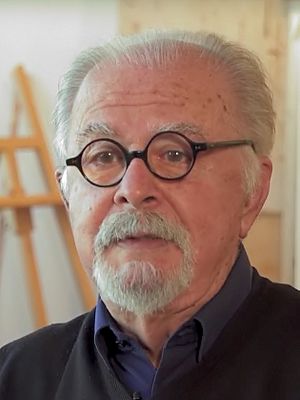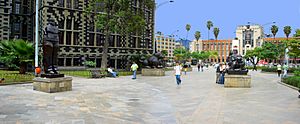Fernando Botero facts for kids
Quick facts for kids
Fernando Botero
|
|
|---|---|

Botero in 2018
|
|
| Born |
Fernando Botero Angulo
19 April 1932 Medellín, Colombia
|
| Died | 15 September 2023 (aged 91) Monte Carlo, Monaco
|
| Known for | Painter, sculptor |
|
Notable work
|
Mona Lisa, Age Twelve (1959), Pope Leo X (after Raphael) (1964), The Presidential Family (1967), The Dancers (1987), Death of Pablo Escobar (1999), Abu Ghraib series (2005) |
| Spouse(s) | |
Fernando Botero Angulo (born April 19, 1932 – died September 15, 2023) was a famous Colombian artist and sculptor. He was born in Medellín, a city in Colombia.
Botero was known for his unique style, called "Boterismo." In his art, he showed people and objects with very large, exaggerated shapes. These big forms could be funny or sometimes show his thoughts on important world events. Many people thought he was the most famous artist from Latin America during his lifetime. You could find his art in big cities like New York City and Paris.
Botero often called himself "the most Colombian of Colombian artists." He became well-known in his home country when he won first prize at a big art show in Colombia in 1958. He started making sculptures after moving to Paris in 1973. By the 1990s, his art was shown all over the world. Many important museums and art collectors own his work. In 2012, he received a special award for his amazing work in modern sculpture.
Contents
About Fernando Botero
His Early Life
Fernando Botero was born in Medellín in 1932. His father, David Botero, was a salesman who traveled by horse. Sadly, his father died when Fernando was only four years old. His mother, Flora Angulo, worked as a seamstress (someone who sews clothes) to support their family. His uncle also played a big role in his life.
Even though Botero didn't visit many art museums when he was young, he was inspired by the old, fancy buildings in Medellín. He also found ideas in the everyday life of his city.
Botero went to school at the Ateneo Antioqueño. Later, he received a scholarship to attend the Jesuit School of Bolívar. When he was 12, his uncle sent him to a school to learn how to be a bullfighter for two years. In 1948, at age 16, Botero's first drawings were printed in El Colombiano, a major newspaper in Medellín. He used the money he earned to pay for high school.
His Art Career
Botero's art was first shown in 1948 with other local artists. From 1949 to 1950, he worked as a designer for theater sets. Then, in 1951, he moved to Bogotá, the capital of Colombia. To support himself and his art, young Botero also drew pictures for newspapers.
His first art show by himself was at the Galería Leo Matiz in Bogotá. In 1952, Botero traveled to Barcelona and then to Madrid, Spain. In Madrid, he studied art at the Academia de San Fernando.
In 1953, Botero moved to Paris, France. He spent a lot of time at the Louvre Museum, studying famous artworks. From 1953 to 1954, he lived in Florence, Italy, where he learned from the great artists of the Renaissance period. Later in life, he mostly lived in Paris, but he would visit his hometown of Medellín for one month each year.
Botero had more than 50 art shows in major cities around the world. His artworks often sold for millions of dollars. In 1958, he won a big art competition in Colombia.
In 2004, Botero showed a series of 50 artworks (drawings and paintings) about the violence happening in Colombia between 1999 and 2004. He gave these artworks to the National Museum of Colombia.
In 2005, Botero became very well-known for his Abu Ghraib series. These artworks showed his thoughts on human rights and difficult events. They were first shown in Europe and then in the United States in 2007. Botero said he would not sell these works. Instead, he gave them to museums. The Berkeley Art Museum received 56 paintings and drawings from this series as a gift from the artist.
After working on the Abu Ghraib series for over a year, Botero returned to earlier themes in 2006. He painted families and mothers, subjects he had explored before. In his painting Une Famille, he showed a Colombian family. In Maternity, he painted a mother and child. The child in the 2006 drawing had a small wound, which some people thought connected the child to Jesus Christ.
In 2008, he showed his The Circus collection, which included 20 oil and watercolor paintings. In 2010, Botero said he was ready to paint other things. He mentioned that he always liked to return to simple subjects like still lifes (paintings of objects like fruit or flowers).
His Unique Style
Botero's art included still lifes and landscapes, but he mostly focused on portraits of people in different situations. His paintings and sculptures are famous for their "fat" or exaggerated figures, as he sometimes called them.
Botero explained why he used these "large people":
"An artist is attracted to certain kinds of form without knowing why. You adopt a position intuitively; only later do you attempt to rationalize or even justify it."
Even though he only spent one month a year in Colombia, he felt he was the "most Colombian artist living." This was because he didn't follow the latest art trends from other countries.
His Sculptures
Between 1963 and 1964, Fernando Botero started trying to make sculptures. He didn't have enough money to work with bronze, so he used acrylic resin and sawdust. One important sculpture from this time was Small Head (Bishop) in 1964. It was painted very realistically. However, the material was too soft, so Botero stopped using it for sculptures.
His Generous Donations

Botero gave many of his artworks to museums in Bogotá and his hometown, Medellín. In 2000, he donated 123 of his own artworks and 85 artworks from his personal collection to the Museo Botero in Bogotá. This collection included works by famous artists like Chagall, Picasso, and Robert Rauschenberg.
He also gave 119 artworks to the Museum of Antioquia in Medellín. This included 23 large bronze sculptures placed in front of the museum, which became known as Botero Plaza. You can find four more of his sculptures nearby in Medellín's Berrio Park and San Antonio Plaza.
To support the Colombian peace process (a plan to end conflict in Colombia), Botero created and donated a sculpture called La paloma de la paz (The Dove of Peace) in 2016. He gave it to the Colombian government to celebrate the peace agreement.
His Personal Life
Botero was married twice. With his first wife, Gloria Zea, he had three children: Fernando, Lina, and Juan Carlos. They separated in 1960. Botero then moved to New York, where he lived for 14 years before moving to Paris.
In 1964, Botero began living with Cecilia Zambrano. They had a son in 1974. Sadly, their son passed away in a car accident in 1979, an accident in which Botero was also hurt. Botero and Zambrano separated in 1975.
Botero's second wife was the Greek artist Sophia Vari. They lived in Paris and Monte Carlo, and also had a house in Pietrasanta, Italy. Botero's 80th birthday was celebrated with an exhibition of his works in Pietrasanta.
His Death
Fernando Botero passed away on September 15, 2023, at the age of 91. He died from problems related to pneumonia.
Botero in Popular Culture
Botero's 1964 painting, Pope Leo X (after Raphael), has become a popular picture on the internet. It is often seen with the funny caption "y tho."
Images for kids
See also
 In Spanish: Fernando Botero para niños
In Spanish: Fernando Botero para niños
- Botero (surname)










